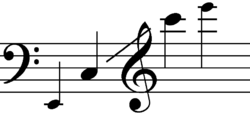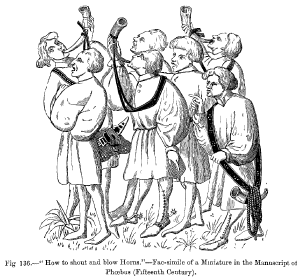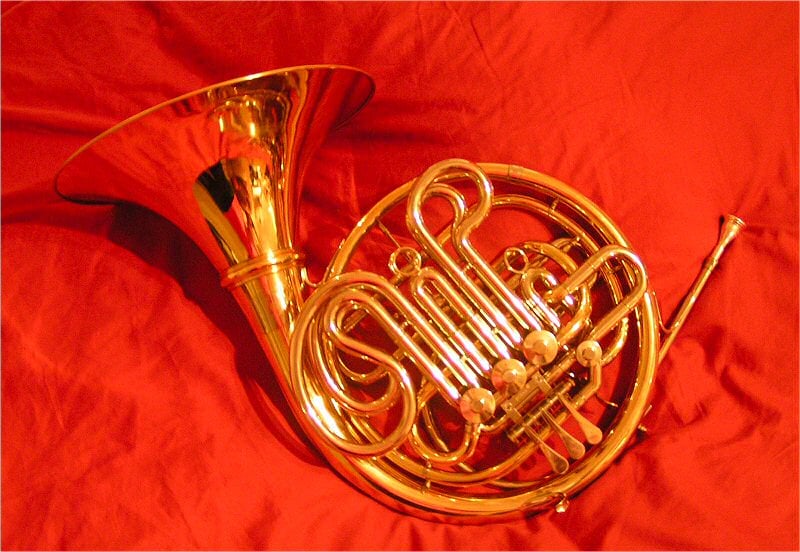Horn
The horn is a brass instrument that consists of tubing wrapped into a coiled form. The instrument was first developed in England as a hunting horn around the year 1650. The French referred to it as the German horn, the Germans called it the hunting horn, and the English called it the French horn. Most musicians usually refer to it simply as the horn. In the 1960s the International Horn Society declared the official name of this instrument to be the "Horn." According to the American Academy of Music, the horn is considered, along with the oboe, the most difficult orchestral instrument to play.
The horn, as a member of the brass instrumental family, is a powerful instrument and is used especially for heroic and bold musical statements in an orchestra in keeping with its original purpose for military calls, religious rites, and hunting signals. Moreover, from the announcement of visiting angels by clarion trumpets to the historical capture of the City of Jericho through the Israel Yemenite shofar or the ram horn shofar, the horns have been very well represented in the religious history of the brass instruments. Additionally, early man connected the traits of truth and goodness to the sound of the horn which was an orientation towards the meaning and purpose of life. Thus, there is a human responsibility to initiate a personal transformation through the sounds and meanings of music and sound.
General Characteristics
The horn is an instrument with a conical bore much like the cornet and Saxhorns. This means the bore is tapered, steadily increasing in diameter along its length, unlike the trumpet and trombone which are considered cylindrical bore instruments. Apart from most other valved brass instruments, which use piston valves, most modern horns use rotary valves, though earlier horns and horns used in Austria and France still use pistons. Each valve toggles a length of tubing, changing the length of the instrument and therefore the pitch. Each length of tubing is a separate part, and is moved to adjust the tuning of the instrument, making them tuning slides. A modern double horn contains a total of 21 ft (6.4 meters) of tubing, including all tuning slides.
Compared to the other brass instruments commonly found in the orchestra, the typical range of the horn is set an octave higher in its harmonic series, facilitated by its small brass mouthpiece. In this range, the "partials" or notes available in a given valve combination performed simply by changing the frequency of the lip buzz, are closer together than on other brass instruments. This makes it easier to play some wrong notes, even among professional players, due to not having the proper lip tension. Its conical bore is largely responsible for its characteristic tone, often described as "mellow." The typical playing range of a horn differs from its written range by a fifth down, and extends from the B-natural below the bass clef (it is possible to play low B flat with embouchure tricks) to the F at the top of the treble clef. Although this is the standard range found in classical repertoire, some players can play many notes beyond this range, both lower and higher.
History
Early horns were much simpler than modern horns. These early horns were brass tubes wound a few times and had a flared opening called the "bell." These early "hunting" horns were originally played on a hunt, often while mounted. Change of pitch was effected entirely by the lips since the horn was not equipped with valves until the nineteenth century.
The horn or, more often, pairs of horns, often invoked the idea of the hunt. Beginning in the later Baroque, the horn would determine the character of the key being played or it would be introduced to represent the nobility, royalty, or divinity.
Early horns were commonly pitched in F, E, E flat, B flat, and C, and since the only notes available were those on the harmonic series of one of those pitches, they had no ability to play in different keys. The remedy for this limitation was the use of crooks, i.e. sections of tubing of differing length that, when inserted, altered the length of the instrument, and thus its pitch.
In orchestras before the invention of valves, the horn section sat with the horns in higher keys sitting on the outside, and those in lower keys on the inside. Thus, the first and third horn would be the "first horn" of their key, and the same would apply to the second and fourth horns. For this reason, in modern music, first and third horn parts are often similar, as are second and fourth.
Starting in the early nineteenth century, horn players began to insert the right hand into the bell to change the length of the instrument, adjusting the tuning as much as a step. This offered more possibilities for playing notes not on the harmonic series being used for that piece. By the early classical period, the horn had become an instrument capable of much melodic playing.
Around 1815, the use of pistons and later rotary valves, were introduced, initially to overcome problems associated with changing crooks during a performance. The use of valves opened up a great deal more flexibility in playing in different keys. In effect, it became an entirely different instrument, fully chromatic for the first time, although valves were originally used primarily as a means to play in different keys without crooks and not for harmonic playing. That is reflected in compositions for horns, which only began to include chromatic passages in the late nineteenth century. When valves were invented, the French made smaller horns with piston valves and the Germans made larger horns with rotary valves. It is the German horn that was referred to in America as the French horn. Many traditional conservatories and players refused to transition at first, claiming that the valveless horn, or "natural horn," was a better instrument. Some musicians still use a natural horn, when playing in original performance styles, seeking to recapture the sound and tenor in which an older piece was written.
Types of horns
Natural Horn
The natural horn is the ancestor of the modern horn. Basically descended from hunting horns, it is controlled by mouthpiece tension, tuning crooks, and the use of the right hand moving in and out of the bell pulling the pitch up and down. Today it is played as an era instrument.
Single Horn
Single horns use a single set of tubes connected to the valves. This allows for simplicity of use and a much lighter weight. They are, however, limited by intervals and tone by having only one key in the horn which would be an F or B-flat. The solution was the development of the double horn. Today, single horns are used mainly by "high" horn players (first and third horns) or by students, as they are sometimes less expensive and lighter than double horns. Additionally, single horns are sometimes used by performers of jazz.
Double Horn
Despite the introduction of valves, the single F horn proved difficult for use in the highest range, where the partials grew closer and closer, making accuracy a great challenge. An early solution was simply to use a horn of higher pitch, usually a B-flat horn. The use of the F versus the B-flat horn became a hotbed of debate between horn players of the late nineteenth century, until Kruspe, the German horn maker, produced a prototype of the double horn in 1897.
The double horn combines two instruments into a single frame: the original horn in F, and a second, higher horn keyed in B-flat. By using a fourth valve (operated by the thumb), the horn player can quickly switch from the deep, warm tones of the F horn to the higher, brighter tones of the B-flat horn. The two sets of tones are commonly called "sides" of the horn.
In the words of Reginald Morley-Pegge, the invention of the double horn "revolutionized horn playing technique almost as much as did the invention of the valve." (Morley-Pegge, "Orchestral," 195)
In the United States, the two most common styles or "wraps" of double horns are named Kruspe and Geyer (also known as Knopf), after the first instrument makers who developed and standardized them. The Kruspe wrap locates the B flat change valve above the first valve, near the thumb. The Geyer wrap has the change valve behind the third valve, near the pinky finger (although the valve's trigger is still played with the thumb). In effect, the air flows in a completely different direction on the other model. Both models have their own strengths and weaknesses, and are a matter of personal choice among horn players. Kruspe wrap horns tend to be larger in the bell throat than the Geyer type.
In the United Kingdom and Europe, the most popular horns are arguably those made by Gebr. Alexander, of Mainz (particularly the Alexander 103), and those made by Paxman in London. In Germany and the Benelux countries, the Alexander 103 is extremely popular. These horns do not fit strictly into the Kruspe or Geyer camps, but have features from both. Alexander prefers the traditional medium bell size, which they have produced for many years, whereas Paxman does offer their models in a range of bell throat sizes.
Compensating Double Horn
The first design of the double horn did not have a separate set of slides pitched in F. Rather, the main key of the horn was B flat (the preference of German horn players) and it could be played in F by directing air through the B flat slides, an F extension, and another set of tiny slides. This "compensated" for the longer length of the F slides, producing a horn now called the "compensating double." It was, and still is, widely used by European horn players because of its light weight and ease of playing, especially in the high register.
Vienna horn
The Vienna horn is a special horn used primarily in Vienna, Austria. Instead of using rotary valves or piston valves, it uses the 'Pumpenvalve'. Much like the Natural horn, this horn uses a system of crooks to change key and because of its longer bell flare, is known for the rich legato sound quality.
Marching Horn
The marching horn is a single horn in B flat, the same key as the B flat side of the double horn, or F alto. Many marching bands, however, use the derivative of the trumpet called the 'mellophone', which usually can only be played by a french horn player with an adapter to allow the french horn mouthpiece to fit in the mellophone's trumpet mouthpiece receiver. The tubing of the instrument has been reconfigured to have a forward-facing bell and vertical piston valves. Although some consider it to have an inferior tone to concert horns, it is used in formation marching for several reasons: the most often mentioned reasons are lower weight, better projection, and a less cumbersome playing position, similar to that of a trumpet, or marching baritone horn.
Wagner tuba
The Wagner tuba is a rare brass instrument that is essentially a modified horn. Invented for Richard Wagner specifically for his work "Der Ring des Nibelungen," it has since been written into other compositions by various composers. It uses a horn mouthpiece and is available in tenor B-flat and bass F.
Other modifications
The triple horn (with an additional F or E flat alto key) is slowly becoming more popular. It remains somewhat of a luxury item as it is both more expensive and heavier than more common double horns.
The horn, although not large, is awkward in its shape and does not lend itself well in transport. To compensate for this, horn makers can make the bell detachable. This allows for smaller and easier to manage horn cases. The player can attach the bell when performing. This also allows for different bells to be used on the same horn, somewhat alleviating the need for multiple horns for different styles.
Repertoire
The horn is most often used as an orchestral instrument, with its singular tone being employed by composers to achieve specific effects. Leopold Mozart, for example, used horns to signify the hunt, as in his Jagdsinfonie (hunting symphony). Once the technique of hand-stopping had been developed, allowing fully chromatic playing, composers began to write seriously for the horn. Telemann wrote much for the horn, and it features prominently in the works of Handel and in Bach's Brandenburg Concerto no. 1. Gustav Mahler made great use of the horn's uniquely haunting and distant sound in his symphonies, notably the famous Nachtmusik (night music) section of his Symphony No. 7.
Many composers have written just one or a few notable works which have become established as favorites in the horn repertoire. These include Poulenc's (Elegie) and Saint-Saëns' (Concertpiece for horn and orchestra, op. 94 and Romance). Others, particularly Mozart, whose father Leopold and friend and patron Joseph Ignaz Leitgeb were both noted horn players, wrote extensively for the instrument including concerti and other solo works. Mozart's A Musical Joke satirizes the limitations of contemporary horn playing, including the risk of selecting the wrong crook by mistake. By the end of the eighteenth century, the horn was sufficiently established as a solo instrument whereby the hornist Giovanni Punto became an international celebrity, touring Europe and inspiring works by composers as significant as Beethoven.
The development of the valve horn was exploited by romantic composers such as Richard Strauss, Bruckner and Mahler. Strauss's Till Eulenspiegels lustige Streiche (Till Eulenspiegel's merry pranks) contains one of the best known horn solos from this period. Wagner featured the horn to such an extent that a special variant, the Wagner tuba, was developed for his Der Ring des Nibelungen, and this was later utilized by Bruckner, Mahler, Schoenberg and others.
English horn music had something of a renaissance in the mid-twentieth century when Dennis Brain inspired works such as Britten's Serenade for Tenor, Horn and Strings and other works from contemporary composers such as Michael Tippett. Peter Maxwell Davies has been commissioned to write a horn piece to commemorate the 50th anniversary of Brain's death.
Much of the repertoire is not scored as featured parts for the orchestral players, especially the principal horn, who is usually the second-highest paid member of the orchestra after the leader. It is common for leading horn players to move from principal positions in the great orchestras to distinguished solo careers.
Notable horn players
- Giovanni Punto, in his day more famous than Beethoven
- Dennis Brain (Royal Philharmonic and Philharmonia Orchestras)
- Barry Tuckwell (London Symphony Orchestra)
- Peter Damm
- David Pyatt (youngest winner of the BBC Young Musician of the Year competition)
ReferencesISBN links support NWE through referral fees
- Humphries, John. The early horn: a practical guide. Cambridge; NY: Cambridge University Press, 2000. ISBN 0-931-34014-4
- Janetzky, Kurt and Bernhard Bruchle. The horn. Portland, OR: Amadeus Press, 1988. ISBN 0-931-34014-4
- Tuckwell, Barry. Horn. NY: Schirmer Books, 1983. ISBN 0-028-71530-6
External links
All links retrieved July 19, 2024.
- Thefrenchhorn.net by Ameerah Morsy
- The International Horn Society
- British Horn Society
- Horn fingering chart
- An online collection of horn orchestral excerpts
- Acoustics of Brass Instruments from Music Acoustics at the University of New South Wales
Credits
New World Encyclopedia writers and editors rewrote and completed the Wikipedia article in accordance with New World Encyclopedia standards. This article abides by terms of the Creative Commons CC-by-sa 3.0 License (CC-by-sa), which may be used and disseminated with proper attribution. Credit is due under the terms of this license that can reference both the New World Encyclopedia contributors and the selfless volunteer contributors of the Wikimedia Foundation. To cite this article click here for a list of acceptable citing formats.The history of earlier contributions by wikipedians is accessible to researchers here:
The history of this article since it was imported to New World Encyclopedia:
Note: Some restrictions may apply to use of individual images which are separately licensed.



